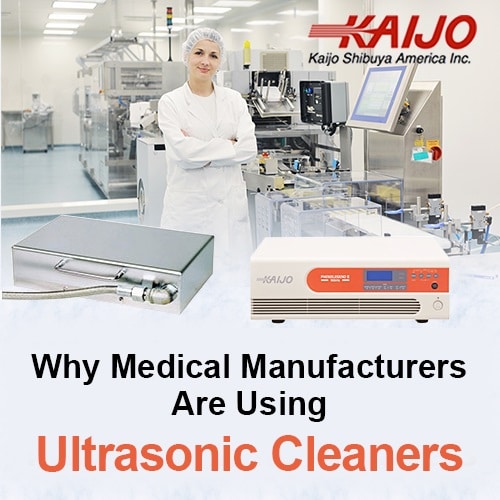Why Medical Manufacturers are Using Ultrasonic Cleaners
August 6, 2021
 Because new technologies have made medical devices harder to clean, medical manufacturers have to explore better ways to clean and sterilize medical equipment. High-pressure steam cleaning and autoclave sterilizing can’t be used for devices that include electronics or other heat-sensitive components. Manual scrubbing traditionally used to remove heavy contamination can scratch fragile optical parts and surfaces that have delicate coatings. Medical manufacturers need gentle, low-temperature cleaning methods that sterilize as well.
Because new technologies have made medical devices harder to clean, medical manufacturers have to explore better ways to clean and sterilize medical equipment. High-pressure steam cleaning and autoclave sterilizing can’t be used for devices that include electronics or other heat-sensitive components. Manual scrubbing traditionally used to remove heavy contamination can scratch fragile optical parts and surfaces that have delicate coatings. Medical manufacturers need gentle, low-temperature cleaning methods that sterilize as well.
Medical ultrasonic cleaners operate at room temperature and can easily clean medical devices with complex shapes or hard-to-reach areas. The cleaning intensity is adjustable from robust cleaning for devices such as implants to gentle cleaning action for delicate instruments. When a disinfectant is added to the cleaning solution, it renders the clean parts sterile. The right medical ultrasonic cleaner can solve many of the cleaning challenges faced by medical manufacturers and can deliver excellent cleaning performance.
Ultrasonic Cleaners Offer Improved Performance Over Traditional Cleaning Methods
Ultrasonic cleaners generate microscopic cavitation bubbles in the cleaning solution. The bubbles form and burst in time with the ultrasonic frequency being applied. When they burst, they create tiny, intense jets of liquid that impact the surfaces of the parts to be cleaned and dislodge contaminants.
Because the cavitation bubbles appear wherever the cleaning solution can penetrate, ultrasonic cleaners can clean devices with complex shapes, dead-end holes, rough areas, and interior spaces that are hard to clean with manual scrubbing. Devices without heavy contamination can be cleaned completely in as little as ten minutes. As a result, ultrasonic cleaners are able to clean more completely than traditional methods and can complete the cleaning tasks more quickly.
Selecting the Right Ultrasonic Cleaner is Critical for Optimal Cleaning Results
Medical cleaning applications range from cleaning during the manufacturing process to final cleaning and sterilization before delivery to medical facilities. Parts to be cleaned can include surgical tools, implants, measuring devices, and fragile instruments. Medical ultrasonic cleaners have to be sized appropriately for the parts to be cleaned. They also must deliver enough power to fill the cleaning tank with ultrasonic waves, and operate at a frequency that is high enough to remove the contamination from the parts to be cleaned, but not damage them.
The choice of frequency is a key element for achieving optimal cleaning performance. Low-frequency ultrasonic cleaners produce comparatively large cavitation bubbles that deliver an intense cleaning action. At higher frequencies, the bubbles are smaller and the cleaning action is less forceful. If the frequency is too low, soft part surfaces may suffer pitting and delicate coatings can be damaged. An experienced ultrasonic cleaning system provider can advise customers on the right frequency for their cleaning application while also addressing cleaning tank size and system power. When the medical ultrasonic cleaner is matched correctly to the cleaning application, cleaning performance is excellent.
Kaijo Can Help Medical Manufacturers Select the Best Ultrasonic Cleaner for Their Application
As an industry-leading ultrasonic cleaner manufacturer, Kaijo is unique in its ability to provide expert advice to medical manufacturers on the ultrasonic equipment best suited for their needs. Depending on your application, ultrasonic cleaners can either be standard turn-key systems for common cleaning applications, or units that are customized to meet special requirements. The knowledgeable specialists at Kaijo can help you select the system with the right set of characteristics, and operating frequency is often the most critical of these. They can also advise you on how to integrate ultrasonic cleaning into their medical manufacturing lines.
Medical manufacturers who switch to ultrasonic cleaning often find that their operations become more efficient as costs are reduced and output quality goes up. When the right medical ultrasonic cleaner is used, medical equipment can be produced with improved cleanliness and in less time. The time you save on cleaning can be re-allocated to do more productive work. Once ultrasonic cleaners are integrated into your medical manufacturing facility, they become an indispensable part of operations.





